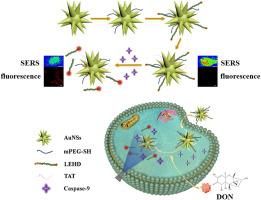多肽功能化金纳米探针用于细胞凋亡过程中 Caspase-9 的 SERS 荧光检测和成像
IF 5.7
2区 化学
Q1 CHEMISTRY, ANALYTICAL
引用次数: 0
摘要
背景脱氧雪腐镰刀菌烯醇是加工谷物食品中常见的真菌毒素之一。它具有耐高温的特点。摄入受 DON 污染的食物会引起不良症状。其细胞毒性主要与表达细胞凋亡和干扰蛋白质合成有关。其中,caspase 家族蛋白酶在不同类型的细胞凋亡信号通路中起着至关重要的作用。结果本文设计了一种多肽功能化金纳米探针,用于在 DON 诱导细胞凋亡过程中实时原位检测活细胞中的 caspase-9。合成了具有良好 LSPR 效果的高各向异性金纳米柱(AuNSs)。它既可以作为表面增强拉曼散射(SERS)基底,也可以通过荧光共振能量转移(FRET)淬灭荧光。含有 LEHD(Leu-Glu-His-Asp)序列的多肽通过 Au-S 键与 AuNSs 连接。在 DON 诱导的细胞凋亡过程中,caspase-9 被激活,可以特异性地裂解识别位点 LEHD,使修饰有罗丹明 B(Rb)信号基团的多肽链脱落并远离 AuNSs,最终降低系统中的 SERS 信号并增强荧光信号。实验结果表明,该纳米探针灵敏度高,线性范围为 5 ng/mL 至 400 ng/mL,最低检测限为 0.38 ng/mL。该方法拓宽了纳米材料的应用范围,并在不同的人体细胞系中具有良好的通用性。它为研究食品安全与细胞平衡机制之间的关系提供了一个新的平台。本文章由计算机程序翻译,如有差异,请以英文原文为准。


Polypeptide functionalized gold nanoprobes for SERS-fluorescence detection and imaging of caspase-9 during apoptosis
Background
Deoxynivalenol is one of the common fungal toxins in processed grain foods. It has the characteristic of high temperature resistance. Dietary intake of DON contaminated food can cause adverse symptoms. Its cytotoxicity is mainly associated with the expression of apoptosis and interfering with protein synthesis. Among which, caspase family proteases play a crucial role in different types of apoptosis signaling pathways. Thus, it is important to develop a platform for real-time and in situ monitoring of caspase in living cells.
Results
In this paper, a polypeptide functionalized gold nanoprobe was designed for real-time and in situ detection of caspase-9 in living cells during DON induced apoptosis. Highly anisotropic gold nanostars (AuNSs) with good LSPR effect were synthesized. It could either serve as the surface enhanced Raman scattering (SERS) substrate or quench fluorescence through fluorescence resonance energy transfer (FRET). Polypeptide containing the LEHD (Leu-Glu-His-Asp) sequence was connected to AuNSs through Au–S bonds. During DON induced cell apoptosis, caspase-9 was activated, which could specifically cleave the recognition site LEHD, causing the polypeptide chain modified with Rhodamine B (Rb) signal group to fall off and move away from AuNSs, ultimately reducing the SERS signal and enhancing the fluorescence signal in the system. The experimental results showed that the nanoprobe had high sensitivity, with a linear range of 5 ng/mL to 400 ng/mL and a minimum detection limit of 0.38 ng/mL.
Significance
This method achieved dual signal quantification and visualization imaging of fluorescence and SERS for caspase-9 in living cells. The application of nanomaterials has been broadened and the assay was well versatile in different human cell lines. It provided a new platform in studying the relationship between food safety and cellular homeostasis mechanisms.
求助全文
通过发布文献求助,成功后即可免费获取论文全文。
去求助
来源期刊

Analytica Chimica Acta
化学-分析化学
CiteScore
10.40
自引率
6.50%
发文量
1081
审稿时长
38 days
期刊介绍:
Analytica Chimica Acta has an open access mirror journal Analytica Chimica Acta: X, sharing the same aims and scope, editorial team, submission system and rigorous peer review.
Analytica Chimica Acta provides a forum for the rapid publication of original research, and critical, comprehensive reviews dealing with all aspects of fundamental and applied modern analytical chemistry. The journal welcomes the submission of research papers which report studies concerning the development of new and significant analytical methodologies. In determining the suitability of submitted articles for publication, particular scrutiny will be placed on the degree of novelty and impact of the research and the extent to which it adds to the existing body of knowledge in analytical chemistry.
 求助内容:
求助内容: 应助结果提醒方式:
应助结果提醒方式:


